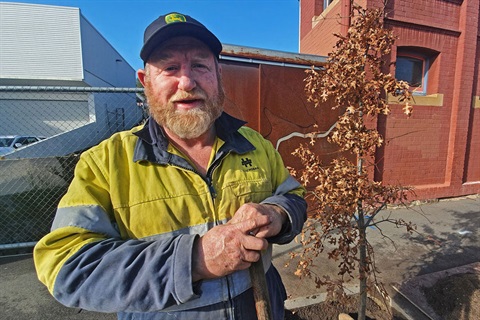People power key to growing Hobart's urban tree canopy
Published on 29 July 2022

The City of Hobart and the Tasmanian Young Planners are teaming up ahead of National Tree Day to show people it's never too late to plant a tree and are encouraging home gardeners and businesses to be part of a movement to green the city.
"While Hobart is surrounded by beautiful forests and woodlands, the CBD and many of our inner suburbs are starkly low on trees," Lord Mayor Anna Reynolds said.
"To celebrate National Tree Day we are teaming up with the Tasmanian Young Planners to plant a number of trees along Collins Street, with the aim of creating a ‘green spine’ to take people from Hobart Rivulet Park into the city centre.
"We are hoping this small action will be one of many to come and will help inspire home gardeners to dig in for National Tree Day and plant a tree in their own garden.
"The City of Hobart controls just a small proportion of the land across the city and so what will really make a big difference for Hobart's future tree canopy is what happens in people’s gardens.
"The best time to plant a tree was 20 years ago, the second best time to plant a tree is now.”
The City of Hobart's green infrastructure plan has a target of planting enough trees across Hobart to create an urban tree canopy of 40 per cent by 2046.
Just 4 per cent of the Hobart CBD is sheltered by the city’s tree canopy. In Hobart's urban and suburban areas this canopy is just over 16 per cent.
"Trees are a vital component of making sure we have a resilient and liveable city into the future so we need to care for and invest in our trees for future generations to enjoy," Lord Mayor Anna Reynolds said.
"If Hobart is to achieve an urban tree canopy of 40 per cent by 2046 we need to protect our current tree population and carry out an ambitious tree planting agenda.”
The Tasmanian Young Planners is a committee of the Planning Institute of Australia. Tasmanian Young Planners Convenor Andrew Holmes says trees and plants have been undervalued in our cities.
“With our future generations in mind, now is the best time to start increasing our urban tree canopy," Mr Holmes said.
“Trees bring so many benefits to our streetscapes, including reducing the temperatures on our footpaths, increasing property values and improving the mental health of our residents.
"Trees create happier and healthier residents, which is fantastic for everyone, including our local businesses.
“The Planning Institute of Australia has identified street trees and walkability as a critical response in our transition towards Climate Conscious Planning Systems. This project is a practical response to PIA’s findings."
Why trees matter
Trees in our cities provide many benefits - they make cities feel like places for people (not just cars), they improve our mental health, encourage people to walk and cycle more and seeing trees and greenery has proven to also make people happier and even more productive at work.
Trees also help cities function better - they reduce the heat that is absorbed and radiated by asphalt, concrete and glass surfaces; they reduce flooding and stormwater runoff by holding water in the canopy and help to scrub the air clean of pollutants and provide natural shelter.